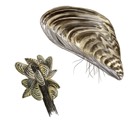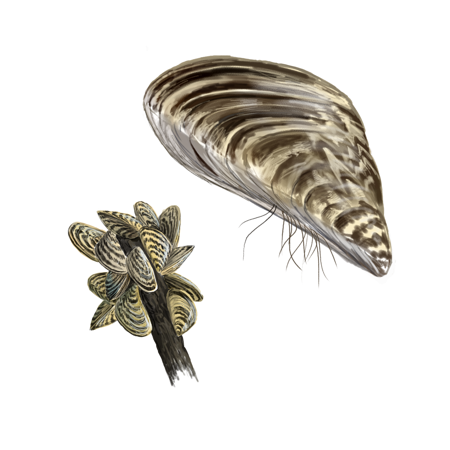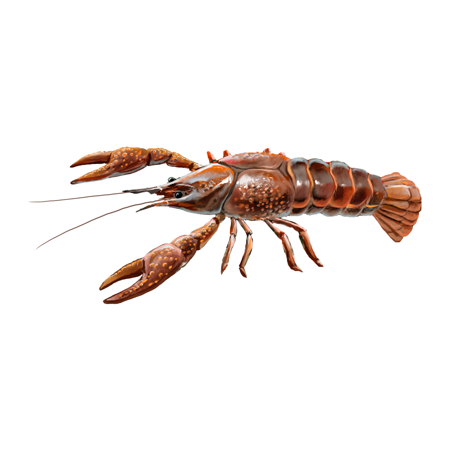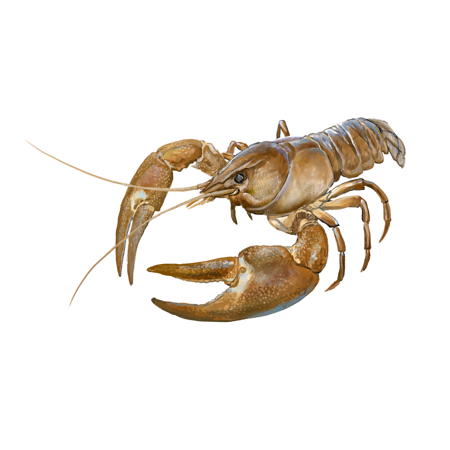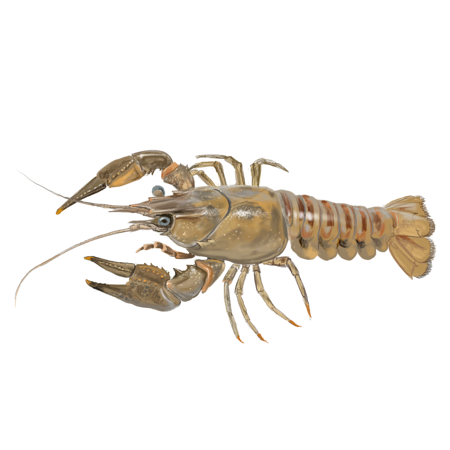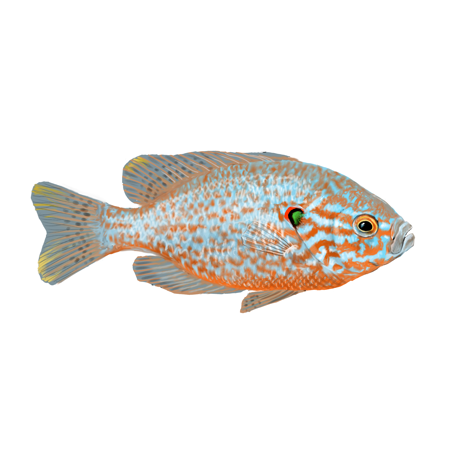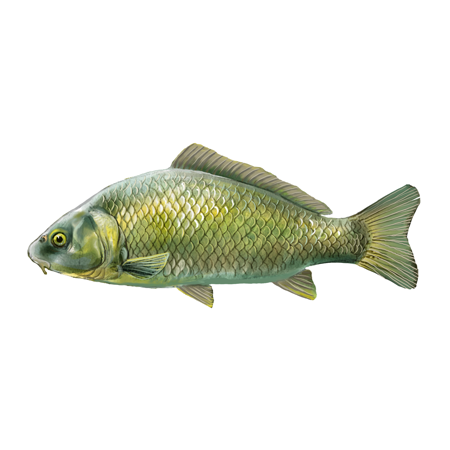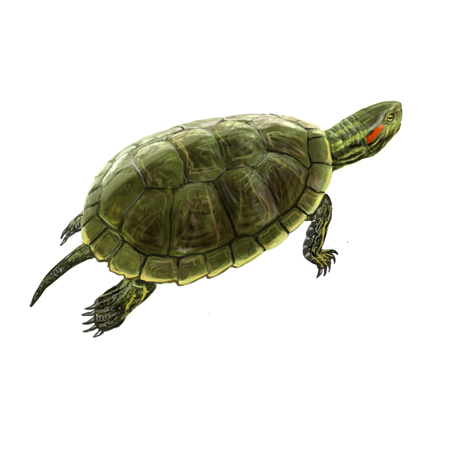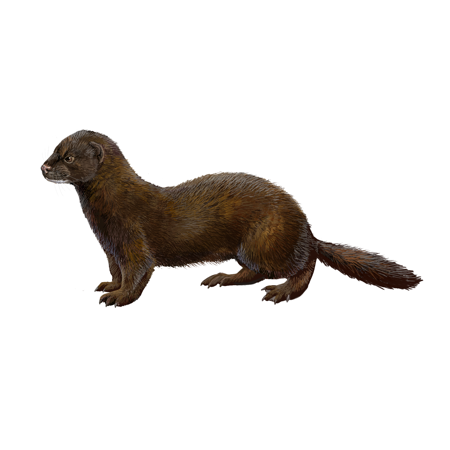Invasive Species
Zebra Mussel (Dreissena polymorpha)
The Zebra Mussel has its origin in the Caspian and Black seas, but nowadays it is introduced all over the world. The way that has reached the new areas, generally, has been linked to human activity such as land transportation, water, movement of machinery, transfers, boats and sport fishing. The introduction and expansion, has also come for navigation and ballast water.
Description and habitat
This mussel, of the Cyrenidae family, is a bivalve of elongated and triangular shape with dark transverse bands often in the form of zigzag. The final part of the shell is very pointed. It can grow up to 4 cm. It is subjected to the substrate by means of an appendix similar to that of marine mussels, forming colonies of thousands of individuals. They are filtering animals and have separate sexes; the fertilization is external giving rise to plankton larvae that are distributed by the column of water. It lives in fresh water, tolerating a certain salinity. It is not common in current waters, but it can be very abundant in reservoirs and lakes.
Ecological problem
It lives in populations of thousands of specimens that overshadow the background causing significant alterations in the trophic chain by displacing the native bivalves. When paying attention to the shells of other mollusks, especially the naiads, it causes their suffocation by preventing breathing. Its enormous filtration activity modifies the transparency of water and causes massive growths of macrophytes. It also modifies the biodiversity of the benthos of the ecosystems that colonizes.
Socio-economic problem
It can cause significant damage to the hydraulic and irrigation infrastructures by covering the circuits and pipes, also in power stations, sewage treatment plants, and also contamination of water due to massive mortalities of the populations. Empty shells on the margins can cause injury to swimmers. Coating of boats (fouling) and all types of hard substrates are also another problem.
Control methods
- Water transfers. You must avoid them as much as possible between different basins.
- Sports fishing. Avoid using it as live bait and disinfecting vessels and utensils.
- Transport of land, water, machinery. Establish disinfection and cleaning protocols, since it is very difficult to detect the presence of larvae.
- Aquarius. It is necessary to avoid being sold in aquarium shops.
- Environmental education and sensitization. In a species that must be included in informative programs for the population to let know the species and its problems.
Control methods
- Mechanical and thermal control
- Chemical control (chlorine, pH decrease, salinity increase)
Red Swamp Crayfish (Procambarus clarkii)
The Red Swamp Crayfish originates from the center and south of the United States (Lousiana) and from northeastern Mexico. It is introduced all over the world. This species has been spread around by aquaculture, and it was introduced in some rice fields of a particular farm for commercial purposes in 1973 in Badajoz. It has a good acclimatization and its production was extended to farms in other areas, some of them without control filters, which favored the escapement of specimens in the wild. Foreign trade of live crayfish for food has favored the entry of this species from Spain to other countries such as the United Kingdom. On the other hand, several releases are also known to "repopulate" rivers and commercial purposes since 1974 through fishermen. Other routes of expansion are sport fishing, aquariums, biological control and natural dispersion.
Description and habitat
It is a crayfish of variable coloration from red to gray with the cephalothorax shell presenting numerous thorns to the sides of the cervical suture. The face has convergent margins and the longitudinal dorsal sutures together. Large clamps with tubers and spikes. It has long antennas. It can reach a size of about 11 cm without tweezers.
Its nutrition is omnivorous, presenting a wide range of food, from insect larvae, fish eggs and amphibians or debris, with preference for animal matter.
Its reproduction begins with fertilization in the autumn by the female, after which the female lays a hundred eggs that are held in the pleopods of the abdomen. In spring, egg hatch and the juveniles stay for a while on the female's abdomen. Under favorable conditions, it can make up to three generations a year.
This species has nocturnal habits, and is very territorial and aggressive. By day, it stays under rocks or in the roots and it can dig hole deep enough, up to 1 meter, to withstand periods of drought and spend the winter. It tolerates low levels of oxygen, high temperatures and some pollution.
They live in soft riverside substrates, rice fields, lakes, marshes, etc. digging tunnels to take refuge. It avoids fast currents.
Ecological problem
It deeply affects the aquatic habitats and the ecosystem. Alteration of the trophic chain and elimination of trophic resources due to its great voracity and the large densities that can be achieved in any course or mass of water, all of which affect the total productivity of the ecosystem. It can also physically affect the natural environment due to excavation habits, destroy benthonic vegetation and generate bioturbation and eutrophication.
It affects the species de indigenous populations of aquatic fauna. Its negative effect on amphibian populations is known, depredating larvae and newt eggs, toads and frogs, and even adults. It also negatively affects some species of fish, mollusks and aquatic invertebrates, and it has been described as a voracious consumer of macrophytic plants.
It is a vector for transmitting Afanomycosis diseases, an infectious disease caused by the fungus Aphanomices astaci that is lethal for the White-clawed Crayfish. The contact of the populations of the Red Swamp Crayfish with those of local crayfish has caused the disappearance of this last one of its main zone of distribution, being relegated to marginalized in isolated areas to upstream of mountain rivers. It is a species that behaves as a bioaccumulator of heavy metals and toxins.
Socio-economic problem
- Diseases. It is a transmitter of Tularemia, a zoonosis detected for the first time in humans in Spain in 1997.
- Agriculture. It causes significant economic damages in the cultivation of rice, both for feeding on seedlings, as well as for the excavation activity that prevents the fixation of plants and alters the hydrology of the soil causing problems in the maintenance of the water level and in water management. The economic losses are determined in 400 million euros per year throughout Europe.
- Commerce. The trade of this species generates important benefits and jobs in certain areas of the south of the Iberian Peninsula where there is an important production industry around the fishing and manufacture of crayfish. The interests of this sector can clash with the necessary conservation and prevention measures.
Preventive measures
- Environmental monitoring. Environmental monitoring must be increased in areas where there is no Red Swamp Crayfish, especially in areas close to native Crayfish populations. Establishing a network of tracking points is one of the most widely used methods.
- Sports fishing. Compliance with current regulations (Fishing Law of Catalonia and Royal Decree) and environmental monitoring. Minimize poaching. The capture of this species requires its sacrifice, and its release to nature is not allowed again.
- Ornamental aquaculture and aquariums. Compliance with current regulations and environmental monitoring. This species cannot be kept captive, nor marketed. Avoid the release of this or any other species.
- Citizen awareness incidence on the general population regarding the problem of invasive species, through specific or general campaigns. In particular, affecting the habit of releasing wildlife in the wild. information to fishermen about the need to disinfect the fishing gear, in order not to disperse the seeds of the fungus that causes the Afanomycosis.
- Commerce. It would be necessary to develop European regulations to control export from areas with crayfish production and to avoid entering new areas by regulating domestic trade between the countries of the European Union.
Control methods
- Intensive and / or sustained mechanical capture
- Use of biocides
- Drying of water bodies
- Containment barriers
- Biological control
- Sterilization
Signal Crayfish (Pacifastacus leniusculus)
It is native to the west coast of North America. It has been introduced to some states in North America, in most European countries (Sweden, France, Austria, Great Britain ...), Japan and Russia. The introduction to the peninsula occurred between 1974 and 1975 in two astacifactories of the provinces of Soria and Guadalajara, near which the first escaped populations were detected. There are also several cases of illegal release to "repopulate" the rivers and for commercial purposes after the authorization of their fishing since 1994 through fishermen. Its wide distribution in Europe is explained because in many places this species was released to replace other extinct native crayfish species, taking advantage of the resistance to the Afanomycosis, the similarity of behavior and the occupation of habitats, and justifying -o also for economic interest. In Catalonia in 2005, it was only present in the river Segre basin, in the Oliana reservoir. During 2006, two new locations were located in Riera Salada and Riera del Merlès in the Llobregat basin, and more recently in the Alt Ter.
Description and habitat
This crayfish has a smooth shell of a brownish color rather uniform with separate longitudinal sutures. The dorsal sutures of the cephalothorax are not spotted. The face has almost parallel margins, which are very characteristic. It has strong and massive clamps, with reddish ventral face. In the union between the fixed fingers and the mobiles of the tweezers a very characteristic stain can be seen, which is what gives its common name. It can reach sizes between 14 and 18 cm in length and weigh around 100-150 grams.
It is an omnivorous crab with a variety of insects, vegetation and detoxification, rapid growth, nocturnal habits and a certain tolerance of pollution. It excavate galleries The female lays between 200 and 400 eggs after mating and keeps them under the tail until they are ready to dislodge in spring. Sexual maturity is achieved after 2 or 3 years, while life expectancy can reach up to 10 years.
It lives in rivers, lakes and even in brackish waters, from the coast to alpine regions. It preferably occupies rocky substrates with good coverage of vegetation and temperate water.
Ecological problem
It effects the aquatic habitats and the ecosystem, as alteration of the trophic chain. It can also physically affect the natural environment due to its digging habits; destroy the vegetation by destabilizing the banks and generating an increase in the load of sediments in the water.
It effects on indigenous species of aquatic fauna. It also causes loss of diversity, mainly because it occupies the same trophic niche that the White-clawed Crayfish (Austropotamobius pallipes) causing its displacement and preventing its recolonization due to more territorial and aggressive behavior, and a higher reproduction rate. Its negative effect on amphibian populations, benthic fish, mollusks and aquatic invertebrates is known, and it has been described that it is also a consumer of macrophytic plants.
It is a vector of Aphanomycosis diseases, an infectious disease caused by the fungus Aphanomices astaci that is lethal for our crayfish. The contact of the populations of this species with those of local river crayfish is lead to the extinction of the latter. In addition, it presents other parasites that are not naturally found in the indigenous crayfish like Psorospermium haeckeli.
Socio-economic problem
Commerce. The trade of this species generates significant benefits in certain areas of the peninsula related to sport fishing. In spite of this, in Europe it is estimated that it causes a loss of 53.28 million euros.
Preventive measures
- Environmental monitoring. Establishing a network of tracking points is one of the most widely used methods. The current fisheries management of this species in some autonomous communities where their capture is allowed above a size, despite prohibiting illegal introductions, favors their dispersion, so it is necessary to take new approaches in this sense more restrictive on a global level.
- Sports fishing. Compliance with current regulations (Fishing Law of Catalonia and Royal Decree) and environmental monitoring. Minimize poaching. The capture of this species requires its sacrifice, and its release to nature is not allowed again.
- Citizen Awareness. Incidence on the general population regarding the problem of invasive species, through specific or general campaigns. In particular, it affects the habit of releasing wildlife in the natural environment. Information to fishermen about the need to disinfect the fishing tackle, in order not to disperse the seeds of the fungus that causes the afanomycosis.
- Commerce. Its commercialization is currently prohibited, not live, or dead, but in some locations its capture for consumption is allowed.
Control methods
- Intensive and / or sustained mechanical capture
- Use of biocides
- Drying of water bodies
- Containment barriers
- Biological control
Spiny-cheek Crayfish (Orconectes limosus)
Is a native species to the northeast of the United States and south-east of Canada. It is introduced in central and western Europe, and also in Russia, Morocco and Asia. The first introduction to Europe dates from 1890 and was followed by a set of releases in other countries, extending rapidly. The initial incentive of the introduction was as an alternative to other species of crayfish that were in decline. The introduction to the Iberian Peninsula is very recent since the first known event is from 2010 in Catalonia, in the reservoir of Boadella, in the Muga basin. The proximity to the French border suggests a furtive illegal introduction from this neighboring country where the species is present abundantly since it entered the 20th century.
Description and habitat
It is a crayfish with an average size of up to 12 cm in length and a weight of up to 79 grams. Its body is relatively smooth but with thorns in different previous parts and also in the back part of post-orbital ridges. It has weakly dentate ridge. It has smooth and yellow clamps in the ventral part and has a thorn in the anterior artillery. The edges of the face are almost parallel, with an orbital crest. It has some black stain which are characteristic, at the end of the clamps and some red marks on each segment of the abdomen are also distinctive features.
It is an omnivorous species; it feeds on organic remains like dead plants and fish, small invertebrates, etc.
It is very tolerant to the variation of water quality, pollution and temperature changes, and it is also active both day and night. It also has a high reproductive potential since a female can reach 450 eggs twice a year.
It occupies rivers and streams with substrata of gravel and slime, and it has also been found in lakes and reservoirs, preferably in deep waters.
Ecological problem
It affects the aquatic habitats and the ecosystem. It causes the alteration of the trophic chain and elimination of trophic resources due to its great voracity and the large densities that can be achieved in any course or mass of water, all of which affect the total productivity of the ecosystem. It can also physically affect the natural environment due to excavation habits, destroy benthonic vegetation and generate bioturbation.
It affects on native species of aquatic fauna; loss of diversity causing local extinctions of aquatic species of fauna and flora. The negative effect on amphibian, fish, mollusks and aquatic invertebrates is known, and it has been described as a voracious predator of macrophage plants.
It is a vector of Aphanomycosis diseases, an infectious disease caused by the fungus Aphanomices astaci that is lethal for our crayfish. The contact of the populations of this species with those of local river crayfish is lead to the extinction of the latter.
Socio-economic problem
Commerce. At the moment, socioeconomic problems have not been described in Catalonia where the species is not widely distributed, and is also not subject to any trade or use by fishermen.
Preventive measures
- Environmental monitoring. Establishing a network of tracking points is one of the most widely used methods. The current fisheries management of this species in some autonomous communities where their capture is allowed above a size, despite prohibiting illegal introductions, favors their dispersion, so it is necessary to take new approaches in this sense more restrictive on a global level.
- Sports fishing. Compliance with current regulations (Fishing Law of Catalonia and Royal Decree) and environmental monitoring. Minimize poaching. The capture of this species requires its sacrifice, and its release to nature is not allowed again.
- Citizen Awareness. Incidence on the general population regarding the problem of invasive species, through specific or general campaigns. In particular, it affects the habit of releasing wildlife in the natural environment. Information to fishermen about the need to disinfect the fishing tackle, in order not to disperse the seeds of the fungus that causes the Afanomycosis.
Control methods
- Intensive and / or sustained mechanical capture
- Use of biocides
- Drying of water bodies
- Containment barriers
Pumpkinseed (Lepomis gibbosus)
The pumpkinseed is original from Central and Eastern Asia. It is widespread throughout the world. In the Iberian Peninsula, it was introduced at the beginning of the 20th century. In Banyoles and Baix Ter areas it arrived in 1910. Its dissemination to other sectors of Catalonia have been accelerated from the 80s of the 20th century through sport fishing since it is used as live bait for fishing of predators. Also, their coloration and behavior make it attractive for aquariums and this can favor their expansion through releases of captive specimens.
Description and habitat
It has a big head with eyes of relatively large size. It has a small mouth with thick lips. Its dorsal and anal fins are double, with a thorny part. The body is tall and compressed laterally. It has 36-47 flakes on the side line. It has bright colors, with a characteristic pattern: blue or turquoise vermiculations on the operculum, large black stain with white and red edges located on the margin of the operculum, and it is generally green on the back and yellow or orange in the stomach, often with orange spots all over and darker vertical bands. It is a small-sized fish, which usually does not exceed 15 cm, but can exceptionally reach 20 cm.
Maximum longevity: 10 years. Sexual maturity occurs from the first year of life. Female lays eggs in nests that the male builds and defends in quiet and shallow areas, after cleaning a small surface of fine substrate. It is a predator, feeding on of a wide kind of preys: benthic invertebrates, plankton, eggs, and small fish, among others.
It presents a certain physiological tolerance to the variations of the temperature and to the contaminated waters.
It lives in rivers, streams, reservoirs, lakes, lagoons, ponds, and other types of water mass. It occupies preferably sectors of low depth with submerged vegetation, and calm waters.
Ecological problem
It has a great ability to reach very high densities in a short time under the right conditions, especially in water bodies where there are no predatory fish.
It effects the native species of aquatic fauna, mainly for competition for trophic and habitat resources, predation of eggs, larvae and juveniles. It causes the disappearance or strong regression of amphibians, certain invertebrates and native small fish.
It also effects the aquatic habitats and the ecosystem, with a waterfall effect on the structure of the ecosystem, due to alteration of the trophic networks.
Preventive measures
- Sports fishing. Compliance with current regulations and environmental monitoring. Minimize furtivism. The captured specimens must always be sacrificed, and they cannot be kept alive, either transported to other spaces or bodies of water, nor can be used as live bait. The captured specimens must be sacrificed.
- Ornamental aquaculture and aquariums. Compliance with current regulations and environmental monitoring. This species cannot be kept captive, nor marketed. Avoid the release of this or any other species from individuals.
- Citizen Awareness Incidence on the general population regarding the problem of invasive alien species, through specific or general campaigns. In particular, the habit of releasing wildlife in the natural environment.
Control methods
- Drying of water bodies
- Use of biocides
- Intensive and/or sustained capture
- Containment barriers
Common Carp (Cyprinus carpio)
The common carp is native to central and south-eastern Europe. In Spain it was introduced during the 17th century. Its dissemination was mainly due to the interest in fishing. It is also used as live bait. In some sectors of Europe it is produced in large quantities by its consumption, and to obtain stocks of repopulation. Ornamental varieties of different colors and forms are often released in pools. They can reach natural environment in case of escape.
Description and habitat
This fish species, from the family of cyprinidae, has a large head with medium-sized eyes. It has a terminal mouth and protector, with fleshy lips. Its sides have a golden tone that is darkened to the back. Its body is wide, but laterally compressed, especially towards the back of the body. The dorsal fin is long and with a first strong radius and sawing. The caudal fin is scissor-divided. It has large scales, and it has between 33 and 40 flakes on the side line. It has a large size (it can reach 150 cm in length), although it does not usually exceed 80 cm. Since it is an intensely domesticated species for thousands of years, there are many morphological varieties that vary greatly in form, color, and in the disposition and size of scales.
It can reach up to 40 years. It reaches the sexual maturity after the second year of life. The egg laying period is preferably given on vegetation and shallow areas, generally where oxygenated and sunny. It’s omnivorous, and it consumes vegetal detritus and especially benthic invertebrates.
It presents a great physiological tolerance to the variations of the temperature, and to very turbid or contaminated waters, especially to the low concentration of oxygen.
It lives mainly in rivers, lakes, reservoirs, lagoons. It prefers stretches of slow and sunny waters.
Ecological problem
It has a great ability to reach very high densities in a short time under the right conditions.
It effects on native species of aquatic fauna, as it has hard competition for the trophic resources and habitat and drastic alteration of their habitats.
It effects on aquatic habitats and the ecosystem, with alterations and severe modifications due to bioturbation (nutrient movement): eutrophication, decrease in water quality, increased turbidity and disappearance of macrophytes, with drastic and general changes in the trophic network, and a global decline in biodiversity. These effects are usually particularly serious in poorer systems with little water renewal.
Socio-economic problem
Its popularity as a fish species has meant that it has not been included as an invasive exotic species in the current regulations, neither in Catalonia nor to the whole of Spain. Currently, its fishing must be practiced without death, except in some localities of the country, as in the case of Estany de Banyoles, where captures of this species must be sacrificed. The practice of fishing involves a risk of propagation of other invasive alien species (for example, zebra mussel).
It also causes decrease in water quality in bathing areas, with landscape interest or supplying of water. It also produces a loss of social or tourist attraction due to the regression of aquatic species of interest (especially birds).
In some environments, such as shallow marshes it can cause sudden massive mortality, especially during drought.
Preventive measures
- Sports fishing. Compliance with current regulations and environmental monitoring. Minimize furtivism. Avoid transport specimens to other spaces or masses of water, nor do irregularly repopulated. It shouldn’t be used as live bait.
- Ornamental aquaculture. Compliance with current regulations and environmental monitoring. Avoid the release of this or any other species from individual or aquaculture production or distribution centers.
- Citizen Awareness Incidence on the general population regarding the problem of invasive alien species, through specific or general campaigns.
Control methods
- Drying of water bodies
- Use of biocides
- Intensive and / or sustained capture
- Containment bars
Florida Pond Turtle (Trachemys scripta elegans and Trachemys scripta scripta)
Known as “Florida Pond Turtles”, a group of several terrapins actually include species such as Trachemys scripta elegans (with red “ears”) and the Trachemys scripta scripta (with a yellow spot on the face). They are native to Mexico and the United States and are introduced all over the world. The entrance way of these turtles has been for growing them in aquariums. It has been imported from the United States for commercialization as a pet company in Spain since 1983, what have also been done with the subspecies Trachemys scripta elegans that Trachemys scripta scripta.
Among the “red-eared turtles”, between 1989 and 1997, up to 52 million individuals were sold in worldwide markets and shops. Prior to the ban on imports, around 250,000 individuals were received annually in Catalonia. Following the prohibition of the European Union in 1997 of importing turtles from the subspecies Trachemys scripta elegans, another set of “American turtle species” were sold in markets, and, among them, some of the “yellow-eared ones”. The two subspecies became popular for its small size, low price and few maintenance requirements. However, the owners get rid of them due to rapid growth to 10-20 cm, increasing food, cleaning and space needs and aggressiveness. From releases, many water bodies have been occupied by them, especially in areas close to urban areas. Both have been reproduced in natural conditions since 1992, but there are indications that even before then, they have already reproduced.
Description and habitat
Both are aquatic turtles with green neck and head with longitudinal yellow lines. One of them has a characteristic elongated red spot in the back of the eyes, while the other one has yellow “ears” with a vertical yellow stain on the cheek and the upper part of the eye. The shell is green in juvenile turtles, with yellow spots, and it gets darker in adults. They have a life expectancy of 20-30 years.
As most reptiles, they need to sunbathe to activate their internal temperature. The diet is omnivorous and they feed on food they capture in the water. Juveniles are more carnivorous than adults. Reproduction is possible at 5-6 years, between March and July. They leave the water to lay eggs and they bury a nest in river slopes, generally from 2 to 20 eggs that hatch after 80 days. The sex of the juveniles is determined by the incubation temperature. In many areas where it has been introduced, it does not reproduce, but it does it where the climate is warmer than in the Mediterranean area. Both two subspecies hybridizes quite commonly by producing hybrid individuals with an intermediate pattern between the two subspecies.
They have totally aquatic habits and they are good swimmers. They often spend many hours on trunks and stones to sunbathe, in a pretty visible way.
They live in calm waters such as ponds, lagoons, lakes, rivers, reservoirs and streams, both of natural and artificial origin. They prefer waters about 1 to 2 meters of depth with abundant vegetation and areas where they can sunbath. They can occupy temporarily flooded environments that leave in the dry season.
Ecological problem
They cause effects on native species of aquatic fauna due to competition for trophic and habitat resources; also predation of eggs, larvae and juveniles of invertebrates, amphibians and fish, and by consuming floating vegetation. They also cause displacement of other species of native aquatic turtles such as pond turtles Emys and Mauremys. Its presence is still too sporadic to determine the specific effect of these species on the ecosystem. However, the same effects can be assumed for other species of turtles of the genus Trachemys or Pseudemys.
Vectors of diseases: domestic animals are often treated with medications to prevent infections, but they can carry diseases, especially parasitic trematods, to native species in case they are released into natural environment.
Socio-economic problem
Transmission of diseases. They are carriers of salmonella and can therefore be transmitted to the children and adults who are in contact.
Preventive methods
- Aquariums. Compliance with current regulations and environmental monitoring. At the moment its inclusion in the national catalog of invasive species prohibits its possession, transport, traffic and commerce of alive or dead specimens. Individuals acquired as pets prior to Royal Decree 630/2013 may remain in captivity but must be informed of it within a period of one year to the competent authority.
- Citizen Awareness Incidence on the general population regarding the problem of invasive alien species, through specific or general campaigns. In particular, affect the habit of releasing wildlife in the natural environment.
- Collection systems. It is essential to establish a system for collecting invasive turtles from private individuals in cities to prevent them from leaving in nature.
Control methods
- Drying of water bodies
- Sustained and/or intensive capture
- Destruction of nests
- Hunting
American Mink (Neovison vison)
The American Mink is native to North America and is introduced in South America, Eurasia and Japan. In Spain, it occupies the northern half of the Iberian Peninsula from Galicia to Catalonia. It was introduced at the end of the 50s of the 20th century, when the first fur farms were installed in Segovia and Pontevedra in order to make coats and leather accessories. Its great commercial interest favored the later installation of numerous farms in other provinces of Galicia, Catalonia and Castilla-Leon during the 70's and 80's, and more recently in Navarra, Euskadi, Cantabria, Aragon, Valencia and Madrid. The number of farms has dropped from 320 to 1989 at 50 in 2011. The problems of those farms due to accidents, acts of vandalism, fire or simply because of the deficiencies of the facilities has allowed these animals to settle in natural ecosystems so that in the early 80's the first mink was seen in the wild. Also, in some regions of Europe some minks have been released deliberately to be able to have a wild population for the hunting with commercial aims. In addition, it has a great capacity to occupy new habitats.
Description and habitat
It is a medium-sized carnivorous mammal, with a slim and elongated body of up to 40 cm (not including the tail, that makes one third of the length of the body). It has a little head with small, rounded ears. It has short and robust legs. This species is very similar to the European mink, Polecat and the Otter. It differs from the otter by its smaller size and for its black fur, with a white spot on the bottom of the lip. The European mink is a bit smaller and lighter in color, and the white stain covers all the snout, lower and upper lip. The European polecat, besides having a white snout, presents a white band behind the eyes like a mask.
Males are bigger than females. It has an interdigital membrane at both hands and feet.
They live along the banks of the rivers and lakes where they build its burrows on the roots of trees, under the bushes, using other animal ones, etc. Sexual maturity is reached at 10-12 months. They mate in the spring and they bread once a year from 2 to 7 young, which are born in summer. Juveniles disperse between August and September. Its maximum longevity is estimated at 4-5 years.
It has twilight customs, although it can be seen during the day. It tolerates human presence. It is an opportunistic and generalist predator that feeds on small mammals, aquatic birds, amphibians, reptiles, fish and small invertebrates such as crustaceans.
It occupies semi-aquatic habitats, both coastal and estuaries, lakes, natural forests, coastal areas, water courses and wetlands.
Ecological problem
It effects the native species of aquatic fauna and it causes the intense decrease of protected species such as native crayfish, Pyrenean Desman in the Pyrenees, waterfowl, aquatic and marine birds, amphibians and fish, and can affect endangered species such as Stickleback or Common Trout. It impacts negatively on the nesting of aquatic birds, especially of the ducs, herons, grebes, crakes... It competes for the same ecological niche with other mustelidae species such as the Polecat, the European Mink and the Otter and tolerates a greater range of contamination and human activity. It may avoid the establishment of new Otter populations. However, in stable populations, Otters are better competitors than American mink. Especially negative is its competence with the European mink, because it is more aggressive and larger.
Vector illnesses; it is disease introducer, among others parvovirus vector of Aleutian disease, in wild populations of European Mink, polecats and otters.
Sport fishing; It has negative effects on populations of wild trout or repopulation affecting the fisheries management of fishing valleys.
Socio-economic problem
- Livestock and aquaculture; severe affections on different human activities such as poultry farms, sheep farms, fish farms, where they capture fish, chickens and newborns.
- Economic activity. The trade of this species generates significant benefits to the fur sector, which makes it difficult to implement drastic measures and the prohibition of this economic practice.
- Fishing or sport hunting. It adversely affects fishing activities on fishing grounds, causing an outrage against the species.
- Control of the species. The tasks of controlling this species to prevent its proliferation cause annual expenses in the European Union of up to 10.5 million euros.
Preventive measures
- Leather production. Compliance with current regulations and environmental monitoring. Reconversion of the fur sector, prohibition of the opening new farms and a greater control of the facilities and activities of current farms to prevent further releases.
- Citizen Awareness: Avoid the actions of animalist groups that release animals to be against trade with animal skins, and which unconsciously cause a serious impact on ecosystems.
- Monitoring. Establish a monitoring network to detect the evolution of the species' expansion, especially in areas of interest due to the presence of the European mink or other threatened Mustelidae species.
Control methods
- Intensive and / or sustained capture
- Biological control
- Use of biocides
- Sterilization











